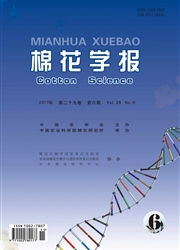

 中文摘要:
中文摘要:
以长江流域推广应用的8个棉花品种为材料,探讨了品种间氮素吸收与利用效率的差异。结果表明:参试品种氯素回收利用效率(RE)差异较大,变化幅度在29.0%-48.2%之间,且高氮素回收利用效率品种具有铃吸氮量、总吸氮量较高、茎叶吸氮量适宜的特征;氮素子棉生产效率(NUEsp)差异也较大.其中泗棉3号和科棉6号较高,分别为20.67kg·kg-1。和20.35kg·k-1。对不同品种RE进行聚类分析结果表明,参试品种可以分为3种类型:类型Ⅰ,回收利用效率高效型;类型Ⅱ,回收利用效率中效型;类型Ⅲ,回收利用效率低效型。NUEsp聚娄分析结果表明,不同品种可以分为2种类型:类型Ⅰ,氮素子棉生产效率高效型;类型Ⅱ,氮素子棉生产效率低效型。进一步分析可知,参试品种RE与NUEsp存在4种类型:即二者都高效型,二者都低效型.高NUEsp和低RE型以及低NUEsp和高RE型。
 英文摘要:
英文摘要:
Eight cotton cultivars, applied in Yangtse River basins, were grown and used to investigate nitrogen uptake and use efficiency difference among cotton cultivars. The results showed that there were large differences in nitrogen recovery efficiency (RE) for eight cotton cultivars, which varied from 29.0%-48.2%. And the cultivars of high RE had appropriate nitrogen accumulation in leaf and stem, higher nitrogen accumulation in bolls and total nitrogen accumulation. There were also large differences in nitrogen use efficiency for seed cotton production (NUEsp) among the eight cultivars. The NUEsp for Simian 3 and Kemian 6 were higher, 20.67 kg·kg-1 and 20.35 kg·kg-1 respectively. Based on a cluster analysis of RE, the cultivars were divided into three groups: a high-efficiency RE type, a middle-efficiency RE type, and a low-efficiency RE type. The cluster analysis of NUEsp showed that the cultivars were divided into two groups: a high-efficiency NUEsp type, and a low-efficiency NUEsp type. Further analysis of RE and NUEsp data indicated that the cultivars were divided into four types: The first group was high-efficiency type both in RE and NUEsp, the second type was low-efficiency type both in RE and NUEsp, the third type was high-efficiency in NUEsp and low-efficiency in RE, and the forth type was high-efficiency in RE and low-efficiency in NUEsp.
 同期刊论文项目
同期刊论文项目
 同项目期刊论文
同项目期刊论文
 期刊信息
期刊信息
